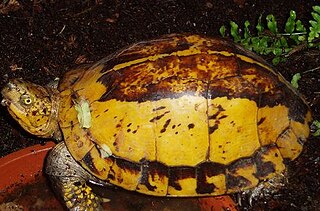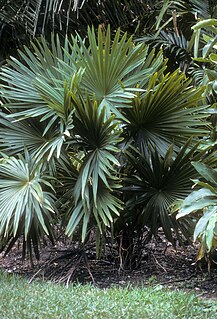
The Indochinese box turtle, Vietnamese box turtle, or flowerback box turtle is a species of Asian box turtles from China, northern and central Vietnam, Laos, and possibly northeastern Cambodia. It is found in high altitude woodland where it tends to hide in the undergrowth. There is considerable confusion as to the taxonomy of this species with several subspecies being recognised by some authorities. and not by others. The International Union for Conservation of Nature has rated its conservation status as "critically endangered".
Cephalotaxus hainanensis is a species of conifer known by the common name Hainan plum-yew. It is endemic to the island of Hainan in southern China. It is possibly a synonym of Cephalotaxus mannii.
The Hainan knobby newt is a species of salamander in the family Salamandridae. It is found only in the island of Hainan, China. It is known from the Wuzhi Mountains, Diaoluoshan, and Jianfengling. All these locations are nature reserves. Nevertheless, the species is threatened by habitat loss and degradation due to agriculture, clear-cutting and infrastructure development for tourist activities.

Chuniophoenix is a genus of palm tree named after Chun Woon-Young, then director of the Botanical Institute, Sun Yat Sen University, Guangzhou. It contains three known species, native to southern China and Vietnam. Chuniophoenix is a member of tribe Chuniophoeniceae, a small group of palms that exhibit great morphological diversity and interesting biogeography. The tribe includes four genera: Chuniophoenix with 3 species in China and Vietnam, Kerriodoxa (monotypic) in Peninsular Malaysia and Thailand, Nannorrhops (monotypic) from Arabia to Afghanistan, and Tahina (monotypic) in Madagascar.

Annam tree frog, also known as the South China tree toad, is a species of frog in the family Hylidae. It is found in southern China, Vietnam, and Laos. The Hainan tree toad from Hainan Island is treated as a subspecies.
Amolops hainanensis is a species of frog in the family Ranidae that is endemic to southwestern and central Hainan, China. Its natural habitats are subtropical or tropical moist lowland forests and rivers. It is threatened by habitat loss.
Odorrana hainanensis is a species of frogs in the family Ranidae that might be endemic to Hainan Island, China; there is one record from Guangxi. Prior to its description in 2001, it was confused with Odorrana andersonii.

The Hainan gymnure or Hainan moonrat is a species of mammal in the family Erinaceidae. Its natural habitat is subtropical or tropical dry forests. It was thought to be endemic to the island of Hainan, China where it is threatened due to habitat loss, but in 2018 was found to also occur in, and be rather common, within Northern Vietnam.
Gmelina hainanensis is a species of tree in the family Lamiaceae. It is a medium-sized tree, up to 15 metres (49 ft) tall, growing on open grassy hillsides and sparse forests. It is found in southern China and in Vietnam.
Hopea hainanensis is a species of tree in the family Dipterocarpaceae. It is found in Hainan Island of China and northern Vietnam. Hopea hainanensis produces the acetylcholinesterase inhibitor Hopeahainol A.
Friesodielsia hainanensis, synonym Richella hainanensis, is a species of plant in the Annonaceae family, native to Hainan. It was first described in 1964. In 2004, it was assessed as "vulnerable"; in 2022, it was listed by Plants of the World Online as "extinct".
Sonneratia hainanensis, the Hainan sonneratia, is a species of plant in the family Lythraceae.
Xenopeltis hainanensis is a non-venomous sunbeam snake species found in China and Vietnam. This is a primitive snake known for its highly iridescent scales. No subspecies are currently recognized.

Craniophora fujianensis is a moth of the family Noctuidae, named for the Fujian province where it was discovered in 2004. The species is found in Fujian and Hainan Provinces in China, but the nominate subspecies is found only in Fujian, and subspecies C. f. hainanensis is restricted to Hainan.
Cycas changjiangensis is a plant species in the cycad order, Cycadales. It is endemic to Hainan Island of southern China. It grows at elevations of 600–800 metres (2,000–2,600 ft). It is found only in a small area in Bawangling 霸王岭国家森林公园, Changjiang County, western Hainan Province, China.

Cycas hainanensis is a species of cycad in Hainan, China. It is protected in some forest reserves and in Tongguling National Nature Reserve (铜鼓岭国家级自然保护区), Wenchang County. In Hainan, it is also found in Wanning and Haikou districts.
Pseudohemiculter hainanensis is a species of freshwater ray-finned fish from the family Cyprinidae, the carps and minnows from south east Asia. It occurs in the Yuanjiang, Zhujiang, Hainan Island, and middle reaches of Changjiang River in China and Vietnam.

Chuniophoeniceae is a tribe of palms in subfamily Coryphoideae of plant family Arecaceae. The four genera within the tribe are morphologically dissimilar and do not have overlapping distributions. Three of the genera are monotypic, while the fourth genus (Chuniophoenix) has three species.
Chieniodendron is a genus of plant in the Annonaceae family. It has only one species Chieniodendron hainanense native to mainland China and Hainan. It is threatened by habitat loss.

Dopasia hainanensis, the Hainan glass lizard, is a species of lizard of the Anguidae family. It is endemic to Hainan Island in China.









